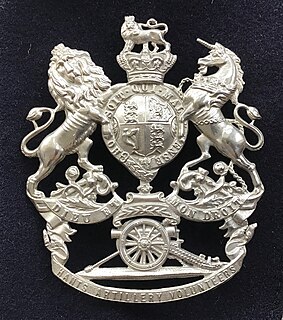
The 1st Wessex Artillery was a volunteer unit of the British Army that existed under various titles from 1860 to 1971, including active service in Mesopotamia in World War I and North Africa and Italy in World War II.
27th Anti-Aircraft Brigade was an Air Defence formation of the British Army in World War II that served in The Blitz and later converted to infantry.
The Tynemouth Volunteer Artillery claims to be the oldest volunteer artillery unit of the British Army. It served coastal and siege guns in World War I and World War II, and also served in the infantry role.

56th (Cornwall) Heavy Anti-Aircraft Regiment, Royal Artillery was a volunteer air defence regiment of Britain's Territorial Army (TA). Originally raised in 1920 as a medium artillery regiment, it was converted to the anti-aircraft role in 1932. During the Second World War, it was employed in Home Defence, in Iceland and then in India, where it was temporarily converted back to medium artillery. Postwar, it reverted to air defence until disbandment in 1955.

The 1st Devonshire Artillery Volunteers and its successor units served in the British Army's Reserve Forces from 1859 to 1961. During World War I it carried out garrison duty in British India but went on to see active service in the Third Anglo-Afghan War. Converting to an air defence role before World War II its units participated in the Norwegian campaign and the Dunkirk evacuation, the Battle of Britain and then the campaigns in North Africa, Italy, and Burma
The 1st Cinque Ports Artillery Volunteers was a part-time unit of the British Army's Royal Artillery from 1860 to 1956. Raised as coastal defence artillery, the unit later served as field artillery in Mesopotamia during World War I, and as anti-aircraft artillery during the Blitz and in the Middle East during World War II.

The 1st Hampshire Artillery Volunteers and its successors were part-time coast defence units of the British Army from 1860 to 1967. Although the units saw no action, they protected the Portsmouth area in both World Wars and supplied trained gunners to siege batteries engaged on the Western Front during World War I. The unit continued in the Territorial Army after World War II.

The Thames and Medway Coast Artillery, which at its peak comprised three full regiments, was formed in Britain's Territorial Army in 1932 to man coastal defence guns on both banks of the Thames Estuary. It served in this role during World War II, at the end of which it sent troops to work in the rear areas in Europe. It was reformed postwar but was broken up when the coast artillery branch was abolished in 1956.

The Northern Division, Royal Artillery, was an administrative grouping of garrison units of the Royal Artillery, Artillery Militia and Artillery Volunteers within the British Army's Northern District from 1882 to 1889.

The Lancashire Division, Royal Artillery, was an administrative grouping of garrison units of the Royal Artillery, Artillery Militia and Artillery Volunteers within the British Army's Northern District from 1882 to 1889.

The Cinque Ports Division, Royal Artillery was an administrative grouping of garrison units of the Royal Artillery, Artillery Militia and Artillery Volunteers within the British Army's South Eastern District from 1882 to 1889.

The London Division, Royal Artillery, was an administrative grouping of garrison units of the Royal Artillery and Artillery Volunteers within the British Army's Home and Woolwich Districts from 1882 to 1889.

The Scottish Division, Royal Artillery, was an administrative grouping of garrison units of the Royal Artillery, Artillery Militia and Artillery Volunteers within the British Army's Scottish District from 1882 to 1889.

The Welsh Division, Royal Artillery, was an administrative grouping of garrison units of the Royal Artillery, Artillery Militia and Artillery Volunteers in the British Army's Western District from 1882 to 1889.

The South Irish Division, Royal Artillery, was an administrative grouping of garrison units of the Royal Artillery and Artillery Militia in Ireland from 1882 to 1889.

The Eastern Division, Royal Artillery, was an administrative grouping of garrison units of the Royal Artillery, Artillery Militia and Artillery Volunteers within the British Army's Eastern District from 1882 to 1902.

The Southern Division, Royal Artillery, was an administrative grouping of garrison units of the Royal Artillery, Artillery Militia and Artillery Volunteers within the British Army's Southern District from 1882 to 1902.

The 'Western Division, Royal Artillery,' was an administrative grouping of garrison units of the Royal Artillery, Artillery Militia and Artillery Volunteers within the British Army's Western District from 1882 to 1902.

The Mountain Division, Royal Artillery, was an administrative grouping of mountain artillery units of the Royal Artillery from 1889. It continued as a distinct branch of the Royal Garrison Artillery until World War I.




